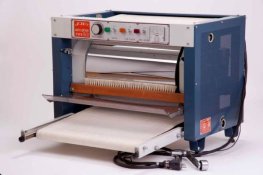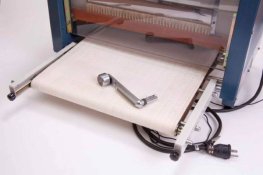Textile science is complex.
Fibres such as cotton and linen, natural fibres, are still processed and given finishing treatments once woven into fabric. It depends on the fibres, and the treatment, and what the fabric is intended for.
The processing treatment is known as sizing. In most cases, with cotton, it should be washed out before the material is used. Some of the stuff used in processing cotton material is really nasty - formaldehyde, for instance. So it was some time ago, at least, when I was working with textiles. I have no idea if it is still used to treat cotton material, but I suspect it is in some instances. What I do know is that with any newly purchased cotton fabrics or garments, I will wash them before use. The smell of sizing is strong, at least to me. It also leaves a certain feel to the fabric itself, stiff and unpleasant.
I do not know if linen fibres and fabrics are subjected to the same treatment when being processed and woven for market.
What does this have to do with material intended for use for drying a fibre print?
Well, just as I will wash a fibre print to remove all trace of fix, I want to make sure the fabric on the print dryer has no residual chemicals in it. Cotton and linen are going to be the preferred fabrics for print driers, in my opinion, for several reasons. They will tolerate higher heat, linen especially, unlike synthetics, and they can be washed at high temperatures, to clean them. Both linen and cotton can be washed - boiled - at 100°C. They will be disinfected as well.
When washing any fabric intended to be used on a print drier, it seems to me that several things need to be considered. If a washing agent is used, it needs to be as neutral as possible, no perfumes, and no fabric softener. Getting the material rinsed as thoroughly as possible is the same thing as removing all traces of fix from a print. You don't want any of that crap remaining, ever.
Type of weave, weight of fabric, all of it is to be considered. I am not familliar with the canvas type fabrics that have been discussed here, so I cannot weigh in on them. In our community darkroom we have a Keinzle print dryer, and the material is a light weight satin weave, probably cotton, as it does fluff and leave annoying fibre particles on prints, still after several years. The satin weave is one that leaves a relatively smooth appearing surface, as opposed to a box weave, chevron, and many others.
I don't know if this is of any help, except to at least stress, please be carefull when washing fabrics that are to be used in print drying. Consider the procedure to be of the same importance as washing your prints. Heat coupled with residual chemicals are relentlessly unforgiving. Fabric softener is an abomination, just do not use it - ever, if possible.












